Cô Mary hướng đẫn vào tham quan khu đội quân đất nung đã được khai quật tù năm 1974
Đội quân đất nung được phát hiện ngày 29 tháng 3 năm 1974 khi một người nông dân đào giếng ở phía Đông núi Lệ Sơn ở nơi có khoảng cách 1,6 kilômét (0,99 mi) phía đông mộ Tần Thủy Hoàng[

national tour guide


chen chân nhau đi xem, quá đông người
đội quân đất nung gồm hơn 6000 lính và có 11 hành lang
góc nào cũng đầy nghẹt người vì là cuối tuần có nghỉ lễ dài
quay film có đủ ánh sáng không?

khu tổng hành dinh có ngựa và tướng lãnh

Show room




đất nặn thành tượng nhanh và rất rõ nét, thật khéo ai muốn đưa hình họ làm rồi gởi cho mình
có áo giáp sẽ oai hơn
Terracotta Army
From Wikipedia, the free encyclopedia
| Mausoleum of the First Qin Emperor | |
|---|---|
| Name as inscribed on the World Heritage List | |
 | |
| Location | China |
| Type | Cultural |
| Criteria | i, iii, iv, vi |
| Reference | 441 |
| UNESCO region | Asia-Pacific |
| Coordinates | 34°23′06″N 109°16′23″ECoordinates: 34°23′06″N 109°16′23″E |
| Inscription history | |
| Inscription | 1987 (11th Session) |
| Terracotta Army | |||
| Simplified Chinese | 兵马俑 | ||
|---|---|---|---|
| Traditional Chinese | 兵馬俑 | ||
| Literal meaning | "Soldier-and-horse funerary statues" | ||
| |||
The Terracotta Army (Chinese: 兵马俑; literally: "Soldier-and-horse funerary statues") is a collection of terracotta sculptures depicting the armies of Qin Shi Huang, the first Emperor of China. It is a form of funerary art buried with the emperor in 210–209 BCE and whose purpose was to protect the emperor in his afterlife.
The figures, dating from approximately the late third century BCE,[1] were discovered in 1974 by local farmers in Lintong District, Xi'an, Shaanxi province. The figures vary in height according to their roles, with the tallest being the generals. The figures include warriors, chariots and horses. Estimates from 2007 were that the three pits containing the Terracotta Army held more than 8,000 soldiers, 130 chariots with 520 horses and 150 cavalry horses, the majority of which remained buried in the pits nearby Qin Shi Huang's mausoleum.[2] Other terracotta non-military figures were found in other pits, including officials, acrobats, strongmen and musicians.
History
The construction of the tomb was described by historian Sima Qian (145–90 BCE) in his most noted work Shiji, written a century after the mausoleum's completion. Work on the mausoleum began in 246 BCE soon after Emperor Qin (then aged 13) ascended the throne, and the project eventually involved 700,000 workers.[3] Geographer Li Daoyuan, writing six centuries after the First Emperor's death, recorded in Shui Jing Zhu that Mount Li was a favoured location due to its auspicious geology, "famed for its jade mines, its northern side was rich in gold, and its southern side rich in beautiful jade; the First Emperor, covetous of its fine reputation, therefore chose to be buried there".[4][5] Sima Qian wrote that the First Emperor was buried with palaces, towers, officials, valuable artifacts and wondrous objects. According to this account, 100 flowing rivers were simulated using mercury, and above them the ceiling was decorated with heavenly bodies below which were the features of the land. Some translations of this passage refer to "models" or "imitations;" however, those words were not used in the original text, which makes no mention of the terracotta army.[3][6]
High levels of mercury were found in the soil of the tomb mound, giving credence to Sima Qian's account.[7]
Later historical accounts suggested that the tomb had been looted by Xiang Yu, a contender for the throne after the death of the first emperor.[8][9][10] However, there are indications that the tomb may not have been plundered.[11]
Discovery
The Terracotta Army was discovered on 29 March 1974[12] to the east of Xi'an in Shaanxi province by farmers digging a water well approximately 1.6 kilometres (0.99 mi) east of the Qin Emperor's tomb mound at Mount Li (Lishan),[13][14] a region riddled with underground springs and watercourses. For centuries, occasional reports mentioned pieces of terracotta figures and fragments of the Qin necropolis – roofing tiles, bricks and chunks of masonry.[15] This discovery prompted Chinese archaeologists to investigate, revealing the largest pottery figurine group ever found in China.
A museum complex has since been constructed over the area, with the largest pit enclosed within with a large structure.[16]
Necropolis
The Terracotta Army is part of a much larger necropolis. Ground-penetrating radar and core sampling have measured the area to be approximately 38 square miles (98 square kilometers).[17]
The necropolis was constructed as a microcosm of the emperor's imperial palace or compound, and covers a large area around the tomb mound of the first emperor. The earthen tomb mound is located at the foot of Mount Li and built in a pyramidal shape,[18] and is surrounded by two solidly built rammed earth walls with gateway entrances. The necropolis consists of several offices, halls, stables, other structures as well as an imperial park placed around the tomb mound.
The warriors stand guard to the east of the tomb. Up to 5 metres (16 ft) of reddish, sandy soil had accumulated over the site in the two millennia following its construction, but archaeologists found evidence of earlier disturbances at the site. During the excavations near the Mount Li burial mound, archaeologists found several graves dating from the eighteenth and nineteenth centuries, where diggers had apparently struck terracotta fragments. These were discarded as worthless and used along with soil to back fill the excavations.[19]
Tomb
Main article: Mausoleum of the First Qin Emperor
The tomb appears to be a hermetically-sealed space the size of a football pitch.[20][21] The tomb remains unopened, possibly due to concerns over preservation of its artifacts.[20]For example, after the excavation of the Terracotta Army, the painted surface present on some terracotta figures began to flake and fade.[22] The lacquer covering the paint can curl in fifteen seconds once exposed to Xi'an's dry air and can flake off in just four minutes.[23]
Excavation site
Pits
Four main pits approximately 7 metres (23 ft) deep have been excavated.[24][25] These are located approximately 1.5 kilometres (0.93 mi) east of the burial mound. The soldiers within were laid out as if to protect the tomb from the east, where all the Qin Emperor's conquered states lay.
Pit one
Pit one, which is 230 metres (750 ft) long and 62 metres (203 ft) wide,[26] contains the main army of more than 6,000 figures.[27] Pit one has 11 corridors, most of which are more than 3 metres (9.8 ft) wide and paved with small bricks with a wooden ceiling supported by large beams and posts. This design was also used for the tombs of nobles and would have resembled palace hallways when built. The wooden ceilings were covered with reed mats and layers of clay for waterproofing, and then mounded with more soil raising them about 2 to 3 metres (6 ft 7 in to 9 ft 10 in) above the surrounding ground level when completed.[28]
Others
Pit two has cavalry and infantry units as well as war chariots and is thought to represent a military guard. Pit three is the command post, with high-ranking officers and a war chariot. Pit four is empty, perhaps left unfinished by its builders.
Some of the figures in pit one and two show fire damage, while remains of burnt ceiling rafters have also been found.[29] These, together with the missing weapons, have been taken as evidence of the reported looting by Xiang Yu and the subsequent burning of the site, which is thought to have caused the roof to collapse and crush the army figures below. The terracotta figures currently on display have been restored from the fragments.
Other pits that formed the necropolis also have been excavated.[30] These pits lie within and outside the walls surrounding the tomb mound. They variously contain bronze carriages, terracotta figures of entertainers such as acrobats and strongmen, officials, stone armour suits, burials sites of horses, rare animals and labourers, as well as bronze cranes and ducks set in an underground park.[31]
Warrior figures
Types and appearance
The terracotta figures are life-sized. They vary in height, uniform, and hairstyle in accordance with rank. The faces appear different for each individual figure, scholars however have identified 10 basic face shapes.[32] The figures are of these general types: armored warriors; unarmored infantrymen; cavalrymen who wear a pillbox hat; helmeted driver of chariots with more armor protection; spear-carrying charioteers; kneeling archers who are armored; standing archers who are not; as well as generals and other lower-ranking officers.[33] There are however many variations in the uniforms within the ranks, for example, some may wear shin pads while others not; they may wear either long or short trousers, some of which may be padded; and their body armors vary depending on rank, function, and position in formation.[34] There are also terracotta horses placed among the warrior figures.
Originally, the figures were painted with bright pigments, variously coloured pink, red, green, blue, black, brown, white and lilac.[35][36] The coloured lacquer finish and individual facial features would have given the figures a realistic feel. However, much of the colour coating had flaked off or become greatly faded.
Some scholars have speculated a possible Hellenistic link to these sculptures, due to the lack of life-sized and realistic sculptures prior to the Qin dynasty.[37][38] They argued that potential Greek influence is particularly evident in some terracotta figures such as those of acrobats, as well as the technique used for casting bronze sculptures.[39][40]
Construction
The terracotta army figures were manufactured in workshops by government laborers and local craftsmen using local materials. Heads, arms, legs, and torsos were created separately and then assembled by luting the pieces together. When completed, the terracotta figures were placed in the pits in precise military formation according to rank and duty.[41]
The faces were created using molds, and at least ten face molds may have been used.[32] Clay was then added after assembly to provide individual facial features to make each figure appear different.[42] It is believed that the warriors' legs were made in much the same way that terracotta drainage pipes were manufactured at the time. This would classify the process as assembly line production, with specific parts manufactured and assembled after being fired, as opposed to crafting one solid piece and subsequently firing it. In those times of tight imperial control, each workshop was required to inscribe its name on items produced to ensure quality control. This has aided modern historians in verifying which workshops were commandeered to make tiles and other mundane items for the terracotta army.
Weaponry
Most of the figures originally held real weapons such as spears, swords, or crossbows, and the use of actual weapons would have increased the figures' realism. Most of the original weapons, however, were looted shortly after the creation of the army, or have rotted away. Nevertheless, many weapons such as swords, spears, lances, battle-axes, scimitars, shields, crossbows, and arrowheads have been found in the pits.[24][43] Over 40,000 bronze items of weaponry have been recovered from the pits, with most of these arrowheads which are usually found in bundles of 100 units.[44] Studies of these arrowheads suggests that they were produced in small units of self-sufficient, autonomous workshops that produced finished items in a production process referred to as cellular production or Toyotism.[45] There are also hundreds of crossbow triggers, and smaller number of other weapons such as bronze swords, and daggers.[46]
Some of these weapons, such as the swords are sharp and were coated with a 10–15 micrometre layer of chromium dioxide that kept the swords rust-free for 2,000 years.[47][48] The swords contain an alloy of copper, tin, and other elements including nickel, magnesium, and cobalt.[49] Some carry inscriptions that date their manufacture to between 245 and 228 BCE, indicating that they were used as weapons before their burials.[50]
An important element of the army is the chariot, of which four types were found. In battle the fighting chariots formed pairs at the head of a unit of infantry. The principal weapon of the charioteers was the ge or dagger-axe, an L-shaped bronze blade mounted on a long shaft used for sweeping and hooking at the enemy. Infantrymen also carried ge on shorter shafts, ji or halberds and spears and lances. For close fighting and defence, both charioteers and infantrymen carried double-edged straight swords. The archers carried crossbows, with sophisticated trigger mechanisms, capable of shooting arrows farther than 800 metres (2,600 ft).[50]
Exhibitions
A collection of 120 objects from the mausoleum and 12 terracotta warriors were displayed at the British Museum in London as its special exhibition "The First Emperor: China's Terracotta Army" from 13 September 2007 to April 2008.[51] This exhibition made 2008 the British Museum's most successful year and made the British Museum the United Kingdom's top cultural attraction between 2007 and 2008.[52][53] The exhibition brought the most visitors to the museum since the King Tutankhamun exhibition in 1972.[52] It was reported that the 400,000 advance tickets sold out so fast that the museum extended its opening hours until midnight.[54] According to The Times, many people had to be turned away, despite the extended hours.[55]During the day of events to mark the Chinese New Year, the crush was so intense that the gates to the museum had to be shut.[55] The Terracotta Army has been described as the only other set of historic artifacts (along with the remnants of wreck of the RMS Titanic) that can draw a crowd by the name alone.[54]
Warriors and other artifacts were exhibited to the public at the Forum de Barcelona in Barcelona between 9 May and 26 September 2004. It was their most successful exhibition ever.[56] The same exhibition was presented at the Fundación Canal de Isabel II in Madrid between October 2004 and January 2005, their most successful ever.[57] From December 2009 to May 2010 the exhibition was shown in the Centro Cultural La Moneda in Santiago de Chile.[58]
The exhibition traveled to North America and visited museums such as the Asian Art Museum of San Francisco, Bowers Museum in Santa Ana, California, Houston Museum of Natural Science, High Museum of Art in Atlanta,[59] National Geographic Society Museum in Washington, D.C. and the Royal Ontario Museum in Toronto.[60] Subsequently, the exhibition traveled to Sweden and was hosted in the Museum of Far Eastern Antiquities between 28 August 2010 and 20 January 2011.[61][62] An exhibition entitled 'The First Emperor – China's Entombed Warriors', presenting 120 artifacts was hosted at the Art Gallery of New South Wales, between 2 December 2010 and 13 March 2011.[63] An exhibition entitled "L'Empereur guerrier de Chine et son armée de terre cuite" ("The Warrior-Emperor of China and his terracotta army"), featuring artifacts including statues from the mausoleum, was hosted by the Montreal Museum of Fine Arts from 11 February 2011 to 26 June 2011.[64] In Italy, from July 2008 to November 16, 2008, five of the warriors of the terracotta army were exposed in Turin at the Museum of Antiquities,[65] and from 16 April 2010 to 5 September 2010 were exposed nine warriors in Milan, at the Royal Palace, at the exhibition entitled "The Two Empires".[66] The group consisted of a horse, a counselor, an archer and 6 Lancers. The "Treasures of Ancient China" exhibition, showcasing two terracotta soldiers and other artifacts, including the Longmen Grottoes Buddhist statues, was held between 19 February 2011 and 7 November 2011 in four locations in India: National Museum of New Delhi, Prince of Wales Museum in Mumbai, Salar Jung Museum in Hyderabad and National Library of India in Kolkata.[citation needed]
Soldiers and related items were on display from March 15, 2013, to November 17, 2013, at the Historical Museum of Bern.[67]
Scientific research
In 2007, scientists at Stanford University and the Advanced Light Source facility in Berkeley, California reported that powder diffraction experiments combined with energy-dispersive X-ray spectroscopy and micro-X-ray fluorescence analysis showed that the process of producing Terracotta figures colored with Chinese purple dye consisting of barium copper silicate was derived from the knowledge gained by Taoist alchemists in their attempts to synthesize jade ornaments.[68][69]
Since 2006, an international team of researchers at the UCL Institute of Archaeology have been using analytical chemistry techniques to uncover more details about the production techniques employed in the creation of the Terracotta Army. Using X-ray fluorescence spectrometry of 40,000 bronze arrowheads bundled in groups of 100, the researchers reported that the arrowheads within a single bundle formed a relatively tight cluster that was different from other bundles. In addition, the presence or absence of metal impurities was consistent within bundles. Based on the arrows’ chemical compositions, the researchers concluded that a cellular manufacturing system similar to the one used in a modern Toyota factory, as opposed to a continuous assembly line in the early days of automobile industry, was employed.[70][71]
Grinding and polishing marks visible under a scanning electron microscope provide evidence for the earliest industrial use of lathes for polishing.[70]
Gallery
See also
Notes
- ^ Lu Yanchou, Zhang Jingzhao, Xie Jun; Jingzhao; Jun; Xueli (1988). "TL dating of pottery sherds and baked soil from the Xian Terracotta Army Site, Shaanxi Province, China". International Journal of Radiation Applications and Instrumentation. Part D. Nuclear Tracks and Radiation Measurements. 14 (1–2): 283–286. doi:10.1016/1359-0189(88)90077-5.
- ^ Portal 2007, p. 167.
- ^ a b Sima Qian – Shiji Volume 6 《史记·秦始皇本纪》 Original text: 始皇初即位,穿治郦山,及并天下,天下徒送诣七十余万人,穿三泉,下铜而致椁,宫观百官奇器珍怪徙臧满之。令匠作机驽矢,有所穿近者辄射之。以水银为百川江河大海,机相灌输,上具天文,下具地理。以人鱼膏为烛,度不灭者久之。二世曰:"先帝后宫非有子者,出焉不宜。" 皆令从死,死者甚众。葬既已下,或言工匠为机,臧皆知之,臧重即泄。大事毕,已臧,闭中羡,下外羡门,尽闭工匠臧者,无复出者。树草木以象山。 Translation: When the First Emperor ascended the throne, the digging and preparation at Mount Li began. After he unified his empire, 700,000 men were sent there from all over his empire. They dug down deep to underground springs, pouring copper to place the outer casing of the coffin. Palaces and viewing towers housing a hundred officials were built and filled with treasures and rare artifacts. Workmen were instructed to make automatic crossbows primed to shoot at intruders. Mercury was used to simulate the hundred rivers, the Yangtze and Yellow River, and the great sea, and set to flow mechanically. Above, the heaven is depicted, below, the geographical features of the land. Candles were made of "mermaid"'s fat which is calculated to burn and not extinguish for a long time. The Second Emperor said: "It is inappropriate for the wives of the late emperor who have no sons to be free", ordered that they should accompany the dead, and a great many died. After the burial, it was suggested that it would be a serious breach if the craftsmen who constructed the tomb and knew of its treasure were to divulge those secrets. Therefore, after the funeral ceremonies had completed, the inner passages and doorways were blocked, and the exit sealed, immediately trapping the workers and craftsmen inside. None could escape. Trees and vegetation were then planted on the tomb mound such that it resembled a hill.
- ^ Clements 2007, p. 158.
- ^ Shui Jing Zhu Chapter 19 《水经注·渭水》Original text: 秦始皇大兴厚葬,营建冢圹于骊戎之山,一名蓝田,其阴多金,其阳多美玉,始皇贪其美名,因而葬焉。
- ^ Portal 2007, p. 17.
- ^ Portal 2007, p. 202.
- ^ Shui Jing Zhu Chapter 19 《水经注·渭水》 Original text: 项羽入关,发之,以三十万人,三十日运物不能穷。关东盗贼,销椁取铜。牧人寻羊,烧之,火延九十日,不能灭。Translation: Xiang Yu entered the gate, sent forth 300,000 men, but they could not finish carrying away his loot in 30 days. Thieves from northeast melted the coffin and took its copper. A shepherd looking for his lost sheep burned the place, the fire lasted 90 days and could not be extinguished.
- ^ Sima Qian – Shiji Volume 8 《史记·高祖本纪》 Original text: 项羽烧秦宫室,掘始皇帝冢,私收其财物 Translation: Xiang Yu burned the Qin palaces, dug up the First Emperor's tomb, and expropriated his possessions.
- ^ Han Shu《汉书·楚元王传》:Original text: "项籍焚其宫室营宇,往者咸见发掘,其后牧儿亡羊,羊入其凿,牧者持火照球羊,失火烧其藏椁。" Translation: Xiang burned the palaces and buildings. Later observers witnessed the excavated site. Afterward a shepherd lost his sheep which went into the dug tunnel; the shepherd held a torch to look for his sheep, and accidentally set fire to the place and burned the coffin.
- ^ "Royal Chinese treasure discovered". BBC News. 2005-10-20. Retrieved 2011-12-03.
- ^ Agnew, Neville (2010-08-03). Conservation of Ancient Sites on the Silk Road. Getty Publications. p. 214. ISBN 9781606060131. Retrieved 11 July 2012.
- ^ O. Louis Mazzatenta. "Emperor Qin's Terracotta Army". National Geographic.
- ^ The precise coordinates are 34°23′5.71″N 109°16′23.19″E)
- ^ Clements 2007, pp. 155, 157, 158, 160–161, 166.
- ^ "Army of Terracotta Warriors". Lonely Planet.
- ^ "Discoveries May Rewrite History of China's Terra-Cotta Warriors". 2016-10-12. Retrieved 2016-10-12.
- ^ 73号 Qin Ling Bei Lu (1970-01-01). "Google maps". Maps.google.co.uk. Retrieved 2011-12-03.
- ^ Clements 2007, p. 160.
- ^ a b "The First Emperor". Channel4.com. Retrieved 2011-12-03.
- ^ "Application of geographical methods to explore the underground palace of the Emperor Qin Shi Huang Mausoleum" (PDF). Google. Retrieved 2011-12-03.
- ^ Nature. "Terracotta Army saved from crack up". Nature.com. Retrieved 2011-12-03.
- ^ Larmer, Brook. "Terra-Cotta Warriors in Color." National Geographic June 2012: 86. Print
- ^ a b "The Necropolis of First Emperor of Qin". History.ucsb.edu. Retrieved 2011-12-03.
- ^ A Magic Army for the Emperor Lothar Ledderose
- ^ Ledderose 1998, pp. 51–73 A Magic Army for the Emperor
- ^ "The Mausoleum of the First Emperor of the Qin Dynasty and Terracotta Warriors and Horses". China.org.cn. 2003-09-12. Retrieved 2011-12-03.
- ^ Portal 2007.
- ^ "China unearths 114 new Terracotta Warriors". BBC News. 2010-05-12. Retrieved 2011-12-03.
- ^ "Terracotta Accessory Pits". Travelchinaguide.com. 2009-10-10. Retrieved 2011-12-03.
- ^ "Decoding the Mausoleum of Emperor Qin Shihuang". China Daily. 2010-05-13. Retrieved 2011-12-03.
- ^ a b The Terra Cotta Warriors. National Geographic Museum. p. 27.
- ^ Cotterell, Maurice (June 2004). The Terracotta Warriors: The Secret Codes of the Emperor's Army. Inner Traditions Bear and Company. pp. 105–112. ISBN 978-1591430339.
- ^ Cotterell, Maurice (June 2004). The Terracotta Warriors: The Secret Codes of the Emperor's Army. Inner Traditions Bear and Company. pp. 103–105. ISBN 978-1591430339.
- ^ John Simpson, Greg Hurst 3 December 2011 12:01 am. "Terracotta soldier – in full colour". The Times. UK. Retrieved 2011-12-03.
- ^ "Terracotta army emerges in its true colors". China Daily. Retrieved 2011-12-03.
- ^ Early links with West likely inspiration for Terracotta Warriors, argues SOAS scholar, School of Oriental and African Studies (SOAS), University of London
- ^ Lukas Nickel, The First Emperor and sculpture in China, SOAS, University of London, Cambridge University Press, 2013
- ^ "Western contact with China began long before Marco Polo, experts say". BBC. 12 October 2016.
- ^ Johnston, Ian (13 October 2016). "Ancient Greeks may have built China's famous Terracotta Army – 1,500 years before Marco Polo". Independent.co.uk. Retrieved 14 October 2016.
- ^ "A Magic Army for the Emperor". Upf.edu. 1979-10-01. Retrieved 2011-12-03.
- ^ Portal 2007, p. 170.
- ^ "Exquisite Weaponry of Terra Cotta Army". Travelchinaguide.com. Retrieved 2011-12-03.
- ^ Marcos Martinón-Torres, Xiuzhen Janice Li, Andrew Bevan, Yin Xia, Zhao Kun, Thilo Rehren (2011). "Making Weapons for the Terracotta Army". Archaeology International. 13: 65–75. doi:10.5334/ai.1316.
- ^ Pinkowski, Jennifer (November 26, 2012). "Chinese terra cotta warriors had real, and very carefully made, weapons". The Washington Post.
- ^ Cotterell, Maurice (June 2004). The Terracotta Warriors: The Secret Codes of the Emperor's Army. Inner Traditions Bear and Company. pp. 99–102. ISBN 978-1591430339.
- ^ "Terracotta Warriors (Terracotta Army)". China Tour Guide. Retrieved 2011-07-28.
- ^ Zhewen Luo (1993). China's imperial tombs and mausoleums. Foreign Languages Press. p. 102. ISBN 7-119-01619-9. Retrieved 2010-06-28.
- ^ "Terracotta Warriors" (PDF). National Geographic. 2009. Retrieved 2011-07-28.
- ^ a b "The First Emperor - China's Terracotta Army - Teacher's Resource Pack" (PDF). British Museum.
- ^ "British Museum - The First Emperor: China's Terracotta Army". British Museum.
- ^ a b Higgins, Charlotte (2008-07-02). "Terracotta army makes British Museum favourite attraction". The Guardian. London. Retrieved 2010-05-25.
- ^ "British Museum sees its most successful year ever". Best Western. 2008-07-03. Archived from the original on 2008-10-11.
- ^ a b "British Museum ponders 24-hour opening for terracotta warriors". CBC News. November 22, 2007.
- ^ a b Whitworth, Damian (2008-07-09). "Is the British Museum the greatest museum on earth?". The Times. London. Retrieved 2010-05-25.
- ^ DesarrolloWeb (2007-04-19). "Los guerreros de Xian, en el Forum de Barcelona". Guiarte.com. Retrieved 2011-12-03.
- ^ "Guerreros de Xian". Futuropasado.com. Retrieved 2011-12-03.
- ^ "Llegan a Chile los legendarios Guerreros de Terracota de China". Latercera.com. Retrieved 2011-12-03.
- ^ "Record-Breaking Terracotta Army Exhibition at Atlanta museum". Retrieved 16 January 2010.
- ^ "ROM's terracotta warriors show a blockbuster". CBC. 6 January 2011.
- ^ "China's Terracotta Army, Stockholm, Sweden, Reviews". Retrieved 20 January 2010.
- ^ "World Famous Terracotta Army Arrives in Stockholm for Exhibition at Ostasiatiska Museum". Retrieved 20 January 2010.
- ^ "Terracotta warriors, Picassos heading to Sydney". ABC News. 14 October 2010. Retrieved 23 January 2011.
- ^ "Empereur Guerrier De Chine Et Son Armee De Terre Cuite". Mbam.qc.ca. Retrieved 2011-12-03.
- ^ "Il Celeste Impero. Guerrieri di terracotta a Torino - Il Sole 24 ORE".
- ^ "Esercito di Terracotta: dalla Cina a Palazzo Reale di Milano - NanoPress Viaggi".
- ^ "Die Terrakotta-Krieger sind da". Der Bund. 22 February 2013. Retrieved 21 June 2015.
- ^ Bertrand, Loïc; Robinet, Laurianne; Thoury, Mathieu; Janssens, Koen; Cohen, Serge X.; Schöder, Sebastian (26 November 2011). "Cultural heritage and archaeology materials studied by synchrotron spectroscopy and imaging". Applied Physics A. 106 (2): 377–396. doi:10.1007/s00339-011-6686-4.
- ^ Liu, Z.; Mehta, A.; Tamura, N.; Pickard, D.; Rong, B.; Zhou, T.; Pianetta, P. (November 2007). "Influence of Taoism on the invention of the purple pigment used on the Qin terracotta warriors". Journal of Archaeological Science. 34 (11): 1878–1883. doi:10.1016/j.jas.2007.01.005.
- ^ a b Rees, Simon (6 March 2014). "Chemistry unearths the secrets of the Terracotta Army". Royal Society of Chemistry. Retrieved 29 March 2014.
- ^ Martinón-Torres, Marcos; Li, Xiuzhen Janice; Bevan, Andrew; Xia, Yin; Zhao, Kun; Rehren, Thilo (20 October 2012). "Forty Thousand Arms for a Single Emperor: From Chemical Data to the Labor Organization Behind the Bronze Arrows of the Terracotta Army". Journal of Archaeological Method and Theory. 21 (3): 534. doi:10.1007/s10816-012-9158-z.
Bibliography
- Clements, Jonathan (18 January 2007). The First Emperor of China. Sutton. ISBN 978-0-7509-3960-7.
- Debaine-Francfort, Corinne (1999). The Search for Ancient China. Thames & Hudson. ISBN 978-0-500-30095-4.
- Dillon, Michael (1998). China: A Historical and Cultural Dictionary. Durham East Asia series. Richmond, Surrey: Curzon. ISBN 978-0-7007-0439-2.
- Portal, Jane (2007). The First Emperor: China's Terracotta Army. Harvard University Press. ISBN 978-0-674-02697-1.
- Ledderose, Lothar (2000). "A Magic Army for the Emperor". Ten Thousand Things: Module and Mass Production in Chinese Art. The A.W. Mellon Lectures in the Fine Arts. Princeton, NJ: Princeton University Press. ISBN 978-0-691-00957-5.
- Perkins, Dorothy (2000). Encyclopedia of China: The Essential Reference to China, Its History and Culture. Facts On File. ISBN 978-0-8160-4374-3.
External links
*****************************************************************
Đội quân đất nung
Bách khoa toàn thư mở Wikipedia
| Lăng mộ Tần Thủy Hoàng cùng các tượng binh mã | |
|---|---|
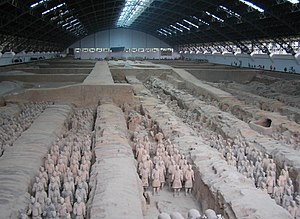 | |
| Quốc gia | |
| Kiểu | văn hóa |
| Hạng mục | i, iii, iv, vi |
| Tham khảo | 441 |
| Vùng UNESCO | Châu Á-Thái Bình Dương |
| Lịch sử công nhận | |
| Công nhận | 1987 (kì thứ 11) |
Đội quân đất nung hay Tượng binh mã Tần Thủy Hoàng (tiếng Hoa phồn thể: 兵馬俑; tiếng Hoa giản thể: 兵马俑; pinyin: bīng mǎ yǒng; Hán-Việt: Binh mã dũng, có nghĩa là "Tượng đội quân và ngựa") là một quần thể tượng người, ngựa bằng đất nung gần Lăng mộ Tần Thủy Hoàng. Đội quân đất nung được phát hiện ngày 29 tháng 3 năm 1974[1] gần thành phố Tây An, tỉnh Thiểm Tây, tây bắc Trung Quốc.
Mục lục
[ẩn]Giới thiệu[sửa | sửa mã nguồn]
Đội quân đất nung được chôn theo Hoàng đế Tần Thủy Hoàng của nhà Tần, trong thời gian 210-209 trước Công nguyên.
Đội quân đất nung được phát hiện ngày 29 tháng 3 năm 1974 khi một người nông dân đào giếng ở phía Đông núi Lệ Sơn ở nơi có khoảng cách 1,6 kilômét (0,99 mi)[Chuyển đổi: Số không hợp lệ] phía đông mộ Tần Thủy Hoàng[2][3]. .
Theo sách sử, việc xây dựng lăng mộ Tần Thủy Hoàng bắt đầu năm 246 trước Công nguyên và sử dụng đến 700.000 nhân công và thợ thủ công trong 38 năm. Hoàng đế Tần Thủy Hoàng được chôn trong quan tài cùng với nhiều ngọc ngà châu báu, nhiều tác phẩm thủ công và một mô hình vũ trụ hoàn chỉnh được khảm ngọc và đặt trong dòng thủy ngân dùng để biểu tượng cho dòng sông đang chảy hoặc có thể dùng để diệt khuẩn và gây độc chết người về sau cho người muốn phá mộ. Những viên trân châu được đặt trên nóc mộ dùng để biểu tượng cho những ngôi sao và các hành tinh. Những khai quật gần đây cho thấy có một lượng thủy ngân cao trong đất của núi Lệ Sơn xác nhận sự trùng hợp với sách cổ.
Lăng mộ Tần Thủy Hoàng gần giống như một kim tự tháp bằng đất cao 76 m và rộng gần 350 m². Cho đến nay lăng mộ này vẫn chưa được khai quật. Trung Quốc đang có kế hoạch xây tường bao và mái bảo vệ khu lăng mộ tránh bị xâm thực của thiên nhiên.
Khu lăng mộ Tần Thủy Hoàng đã được thiết kế như một tổ hợp các cung điện đền đài bao quanh bởi thành quách. Để giữ bí mật thông tin về lối vào mộ và của cải trong đó Nhà Tần đã giết hết lực lượng tham gia xây dựng khu lăng mộ bằng cách bít đường ra vào lăng mộ và chôn sống họ cũng như giết hết một số người liên quan đến việc chôn sống này. Đội quân đất nung được xây dựng kế bên nhằm mục đích bảo vệ cho Tần Thủy Hoàng sau khi ông qua đời.
Người ta đã phát hiện thấy mức thủy ngân cao trong đất ở gò đất mộ, đã minh chứng cho ghi chép của Tư Mã Thiên[4].
Các ghi chép lịch sử sau này cho rằng ngôi mộ đã bị Hạng Vũ cướp phá[5][6][7] Tuy nhiên, đã có những dấu hiệu cho thấy ngôi mộ đã không bị cướp bóc.[8].
Khảo cổ[sửa | sửa mã nguồn]
Kể từ khi được phát hiện ra năm 1974, việc khai quật khảo cổ vẫn được tiến hành trong thời gian qua. Việc khai quật kéo dài do binh mã bằng đất nung rất dễ vỡ và việc bảo vệ những bức tượng này rất khó khăn (bị phong hóa, bị vi khuẩn phá hoại...). Những tượng binh mã được nặn từ đất sét, nung trong lò ở nhiệt độ thấp, sau khi nung xong được phết một lớp sơn lên bên ngoài để tăng độ bền. Khuôn mặt, kích cỡ, màu sơn theo các nhà khảo cổ không có tượng nào giống nhau, sống động như đội quân thật.
Cho đến nay đã có 8.099 pho tượng đã được khai quật ra khỏi lòng đất. Các bức tượng người có lính bộ binh, cung thủ, các tướng lĩnh trong tư thế đứng thẳng hoặc cúi mình cầm cung, kích, giáo, mác, gươm bọc đồng... đây là những vũ khí được sử dụng ở Trung Hoa thời đó. Ngoài tượng binh mã, tượng xe ngựa có kích cỡ và tinh xảo như thật cũng được phát hiện trong khu tượng binh mã. Quần thể tượng được đặt trong 3 hầm mộ riêng biệt, hầm mộ thứ 4 là hầm trống. Người ta cho rằng, hầm mộ thứ nhất có pho tượng 6000 binh mã, là đội quân chủ lực của Tần Thủy Hoàng. Hầm mộ thứ nhất nằm mặt Tây của Lăng mộ. Hầm mộ thứ hai chứa khoảng 1400 pho tượng kỵ binh và bộ binh đi cùng xe ngựa, đây được xem là đội cảnh binh, trên diện tích 19.659 m². Hầm mộ thứ ba là đội chỉ huy các cấp khác nhau và một xe tứ mã trên diện tích 1524 m² có 68 pho tượng.
Hình ảnh[sửa | sửa mã nguồn]
Tham khảo[sửa | sửa mã nguồn]
- ^ Agnew, Neville (3 tháng 8 năm 2010). Conservation of Ancient Sites on the Silk Road. Getty Publications. tr. 214. ISBN 9781606060131. Truy cập ngày 11 tháng 7 năm 2012.
- ^ O. Louis Mazzatenta. “Emperor Qin's Terracotta Army”. National Geographic.
- ^ Tọa độ chính xác là 34°23′5,71″B 109°16′23,19″ĐTọa độ: 34°23′5,71″B 109°16′23,19″Đ)
- ^ Portal 2007, tr. 202.
- ^ Shui Jing Zhu Chapter 19 《水经注·渭水》 Original text: 项羽入关,发之,以三十万人,三十日运物不能穷。关东盗贼,销椁取铜。牧人寻羊,烧之,火延九十日,不能灭。Translation: Xiang Yu entered the gate, sent forth 300,000 men, but they could not finish carrying away his loot in 30 days. Thieves from northeast melted the coffin and took its copper. A shepherd looking for his lost sheep burned the place, the fire lasted 90 days and could not be extinguished.
- ^ Sima Qian – Shiji Volume 8 《史记·高祖本纪》 Original text: 项羽烧秦宫室,掘始皇帝冢,私收其财物 Translation: Xiang Yu burned the Qin palaces, dug up the First Emperor's tomb, and expropriated his possessions.
- ^ Han Shu《汉书·楚元王传》:Original text: "项籍焚其宫室营宇,往者咸见发掘,其后牧儿亡羊,羊入其凿,牧者持火照球羊,失火烧其藏椁。" Translation: Xiang burned the palaces and buildings. Later observers witnessed the excavated site. Afterward a shepherd lost his sheep which went into the dug tunnel; the shepherd held a torch to look for his sheep, and accidentally set fire to the place and burned the coffin.
- ^ “Royal Chinese treasure discovered”. BBC News. 20 tháng 10 năm 2005. Truy cập ngày 3 tháng 12 năm 2011.



























































































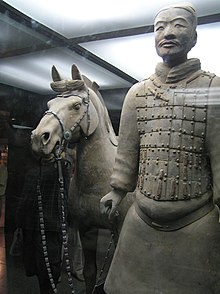
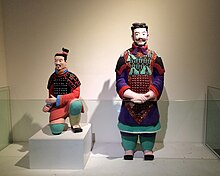


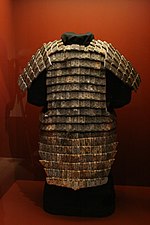


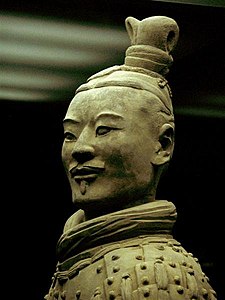
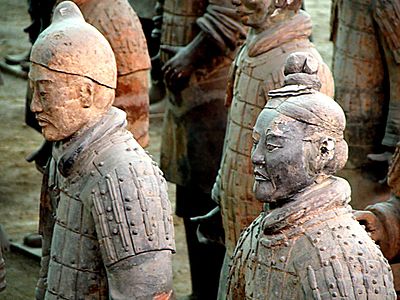
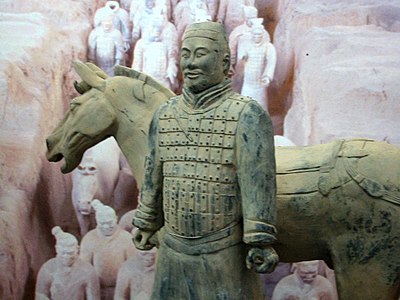
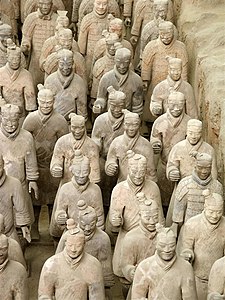



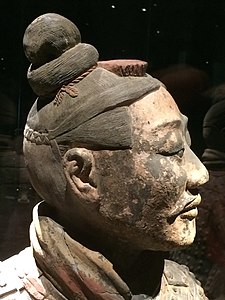

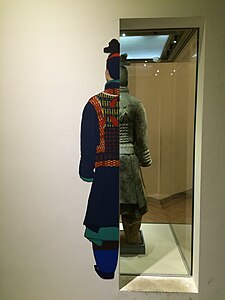



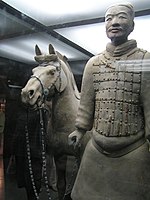









Aucun commentaire:
Enregistrer un commentaire